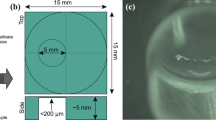Abstract
Electrochemical experiments in combination with infrared spectroscopy and subsurface concentration profiling yielded information on ionic processes at the membrane surface of glass electrodes and resulted in a detailed mechanism of the glass electrode response. This “dissociation mechanism” is based on phase boundary equilibria between anionic groups at the glass surface and hydrogen or alkali ions in the solution, which control the potential of the glass and the concentrations of ions attached to the surface groups. The resulting concentration gradients between glass surface and bulk glass cause an interdiffusion of the different ions, if they are not hindered sterically to penetrate into the glass, and a diffusion potential beneath the glass surface. The interdiffusion determines the course of the glass corrosion, which thus depends on whether protons or alkali ions are attached to the surface and interdiffuse with the alkali ions of the glass, leading, respectively, to a steady-state leached layer or a continuously growing alkali-exchanged layer. pH electrodes with La2O3-containing membrane glasses show delayed interfering potential drifts in neutral and alkali phosphate and fluoride solutions caused by LaPO4 and LaF3 deposits, respectively, at the membrane surface (“phosphate” and “fluoride errors”). Equations for the phase boundary potential and phase boundary concentrations are derived on a thermodynamic and kinetic basis and are verified experimentally. Glass leaching and alkali ion interdiffusion are studied, and the diffusion potential within a leached layer is determined. The formation periods of pH and of pM glass electrodes are explained, and an indirect part of the sodium error and an irreversible sodium error are detected. Leached and alkali-exchanged layers consist of modified glass and are not “gel” layers as generally assumed. Large exchange current densities of the phase boundary equilibria explain the stability of glass electrode potentials. Migration experiments with subsequent concentration profiling showed that glasses can be alkali ion, proton, and mixed alkali ion-proton conductors and yielded concentration-dependent mobilities of lithium ions and replacing protons in a lithium silicate glass. The unchanged pH response of membranes before and after field-driven protonation, in alkali-free solutions, excludes the exchange of different ions as the origin of the glass electrode response, as assumed by the ion exchange theory, and verifies the dissociation mechanism.
Similar content being viewed by others
References
Nernst W (1892) J Phys Chem 9:137
Cremer M (1906) Z Biol 47:562
Haber F, Klemensiewicz Z (1909) Z Phys Chem 67:385
Schwabe K, Dahms H (1961) Z Elektrochem, Ber Bunsenges Phys Chem 65:518
Eisenman G (1967) In: Eisenman G (ed) Glass electrodes for hydrogen and other cations, chapter 5. Dekker, New York, pp 133–173
Nicolsky BP (1937) Acta Physicochim USSR 7:597
Eisenman G, Rudin DO, Casby JO (1957) Science 126:831
Karreman G, Eisenman G (1962) Bull Math Biophys 24:413
Nicolsky BP, Shultz MM, Belijustin AA, Lev AA (1967) In: Eisenman G (ed) Glass electrodes for hydrogen and other cations, chapter 6. Dekker, New York, pp 174–222
Eisenman G (1962) Biophys J [Suppl]:2(2):259
Cammann K (1975) Dissertation, Munich
Boksay Z, Bouquet G, Dobos S (1967) Phys Chem Glasses 8:140
Bach H (1970) Z Angew Phys 28:239
Bach H, Baucke FGK (1971) Electrochim Acta 16:1311
Baucke FGK (1974) J Noncryst Solids 14:13
Baucke FGK (1975) J Noncryst Solids 19:75
Baucke FGK (1977) In: Pungor E (ed) Ion-selective electrodes. Elsevier, Amsterdam Oxford New York, pp 215–234
Baucke FGK (1981) In: The glassy state. Proceedings of the All-Union Conference, Leningrad, October 13–15, 1981 (Acad Sci USSR, Leningrad 1983), p 96
Bach H, Baucke FGK (1974) Phys Chem Glasses 15:123
Baucke FGK (1975) In: Cooper AR, Heuer AH (eds) Proceedings of the 9th University Conference on Ceram Science, June 3–5, 1974, Cleveland, p 337
Baucke FGK (1980) J Noncryst Solids 40:159
Baucke FGK (1977) In: Frischat GH (ed) The physics of non-crystalline solids. Trans Tech Publ, Aedermannsdorf, p 503
Baucke FGK (1977) In: Proceedings of the International Congress on Glass, CVTS Dům techniky Praha, Prague, p 347
Duffy JA, Baucke FGK (1980) J Electrochem Soc 127:2230
Baucke FGK, Bach H (1982) J Amer Ceram Soc 65:534
Duffy JA, Baucke FGK (1983) J Chem Soc Farad Trans A 79:661
Baucke FGK (1987) Diff and Defect Data 53–54:197
Baucke FGK (1991) J Noncryst Solids 129:233
Baucke FGK (1985) J Noncryst Solids 73:215
Baucke FGK (1985) In: Proceedings of the Conference on Glass Current Issues, Tenerife, Spain, April 2–13, 1984. NATO ASI Series, Appl Sci Eng. Nijhoff, The Hague, p 481
Bach H, Baucke FGK (1982) J Am Ceram Soc 65:527
Lanford WA (1978) Nucl Instrum & Methods 149:1
Engelmann C, Nens B, Trocellier P (1981) Verres Refract 36:486
Baucke FGK (1994) J Electroanal Chem 367:131
Guggenheim EA (1967) Thermodynamics. Wiley, Amsterdam New York, pp 298–299
Schwabe K, Dahms H (1959) Monatsber Deutsch Akad Wiss Berlin 1:279
Hammond PR (1962) Chem Ind (London), p 311
Wikby A (1974) Phys Chem Glasses 15:37
Eisenman G (1965) Adv Anal Chem Instr 4:213
Conti F, Eisenman G (1965) Biophysical J 5:247
Dutz H (1966) Glastechn Ber 39:139
Cammann K (1977) Das Arbeiten mit ionenselektiven Elektroden, 2. Aufl., Springer, Berlin Heidelberg New York, p 57
US Pat No 4,028,196. June 7 (1977)
Rechnitz GA (1967) In: Eisenman G (ed) Glass electrodes for hydrogen and other cations. Dekker, New York, p 331
Author information
Authors and Affiliations
Rights and permissions
About this article
Cite this article
Baucke, F.G.K. The modern understanding of the glass electrode response. Fresenius J Anal Chem 349, 582–596 (1994). https://doi.org/10.1007/BF00323462
Received:
Issue Date:
DOI: https://doi.org/10.1007/BF00323462




